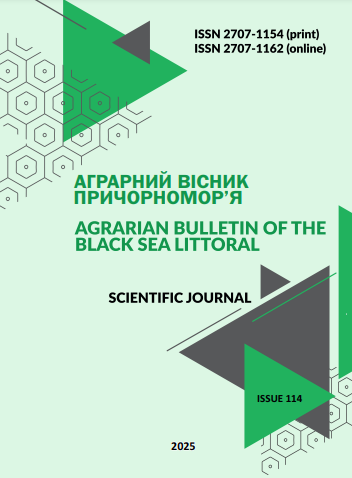PROCESSING AND DISINFECTION OF BARLEY FEED GRAIN
DOI:
https://doi.org/10.37000/abbsl.2025.114.14Keywords:
barley, spoilage, processing, quality, exposure.Abstract
Seeds are biological entities known to release water through respiration. Within a silo, this moisture is distributed upward due to convective air currents. This phenomenon occurs as a result of the temperature differential between the warmer seeds at the silo's center and the cooler walls. If grain is stored at a humidity level below 12% and protected from insect infestation, increases in humidity in the upper layers of the seeds will likely remain minimal.
Conversely, should the grain be stored with humidity exceeding 12%, sufficient moisture can develop on the upper layer, fostering mold growth. Such conditions lead to microbial proliferation, rendering the grain unsuitable for livestock, poultry feed, and other by-products. Consequently, the eradication of harmful microflora during grain processing and storage represents a critical concern for farmers. Deficiencies in the final product may arise from the utilization of low-quality grain, deviations from production protocols, and non-adherence to established storage conditions and requirements.
The primary defects comprise impairments in organic and physicochemical properties, as well as microdefects. To avert contamination of food products, grains, and seeds, it is imperative that food grains undergo sterilization and disinfection above the prescribed standards prior to storage and transportation. The predominant methods of sterilization and disinfection include chemical coatings, thermal treatments, and cold treatments, or a combination of these biological approaches.
A key factor contributing to spoilage is the moisture content of the grains; thus, heating, utilizing the dry heat mechanism, has gained acceptance among major storage and transportation entities. To inhibit microbial activity, ultraviolet radiation (UV radiation) serves as an effective treatment method, utilized to disrupt microbial activity and eliminate grain pests through the interaction with electromagnetic radiation in the spectrum between visible light and X-rays.
References
Bryndzia Z. F., Dzhula I. O.(2010). System of technologies in crop production. Ternopil: Consulting Center. 188 p. [in Ukrainian].
Mankivskyi A.Ya. (2002). Technology of storage and processing of agricultural products. Nizhyn: VKP Aspect. 211 р.
Khomyk N.I., Oleksiuk V.P., Tsyon O.P. (2016). Mechanization of processing and storage of agricultural products. Ternopil: FOP Palyanytsya V.A. 288 p. . [in Ukrainian].
Gursky P.V.(2021). Installation, repair, adjustment of food production equipment. Kharkiv: KhDATOKH. 230 p. [in Ukrainian].
Bernyk P.S.(2004). Mechanical processes and equipment for processing and food production. Lviv: Lviv Polytechnic, 336 p. [in Ukrainian].
Lyubych V., Novikov V., Polyanetska I., Usyk S. (2019). Improvement of the process of hydrothermal treatment of wheat grain in the production of cereals. European Journal of Enterprise Technologies . Vol. 3/11 (99) .Р. 40-51.
Dudarev I. (2016). Processing and frictional properties of grain. Agrarian Bulletin of the Black Sea Region, Issue 80, Р. 137–144. [in Ukrainian].
I.I. Dudarev, S.M. Uminskyi, I.V. Moskalyuk (2022). Justification of the operational parameters of the disc feed chopper. Odesa. "TES", 140 p. [in Ukrainian].
Dudarev I.I. (2014) Grain moisture. Agrarian Bulletin of the Black Sea Region, Issue 74, Р.129–132. [in Ukrainian].
Dudarev I.I. (2015). Hulling of moistened grain. Agrarian Bulletin of the Black Sea Region, Issue 78, Р.141–149. [in Ukrainian].
Zapletnikov I.M. Operation and maintenance of technological equipment of food production. Kyiv: Center for Educational Literature, 2022, 344 p.
Myronchuk V.G. (2017). Repair and operation of equipment of food production: Kyiv: NUHT, 118 p. [in Ukrainian].
Macrae, R., Robinson K., Sadler M.(2020) Encyclopaedia of Food Science, Food Technology, and Nutrition. Academic Press: New York, 234 p. [in USA].
Myronchuk V.G., Lyulka D.M. (2017). Installation and technical service of equipment. Kyiv: NUHT, 162 p. [in Ukrainian].
Reichert R. D., Oomah B.D., Youngs C.G.(2004).Factors affecting the efficiency of abrasive peeling of legume grains were investigated using a new intermediate batch peeler. J Food Sci. Vol. 49:Р. 267–273. doi: 10.1111/j.1365-2621.1984.tb13723.x [in Italy].
Czaja T., Sobota А., Szostak R. (2020). Quantification of Ash and Moisture in Wheat Flour by Raman Spectroscopy. Foods, Vol. 9(3), Р. 280-289. https://doi.org/10.3390/foods9030280. [in Italy].
Lisovenko O.T. (2010).Technological equipment for bakery and pasta production. Kyiv: Naukova Dumka. 181 p. [in Ukrainian].
Downloads
Published
How to Cite
Issue
Section
License

This work is licensed under a Creative Commons Attribution-NonCommercial 4.0 International License.


